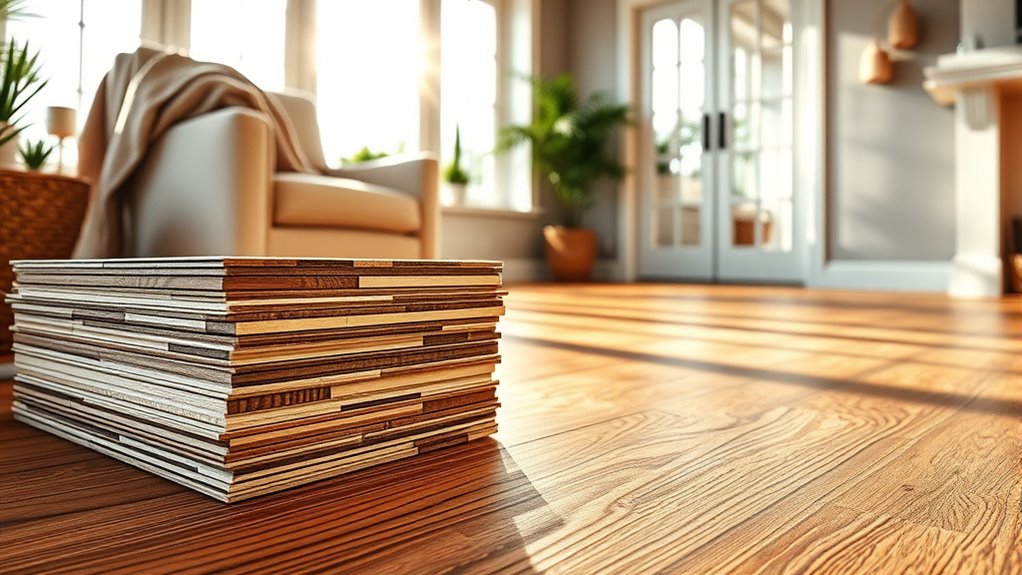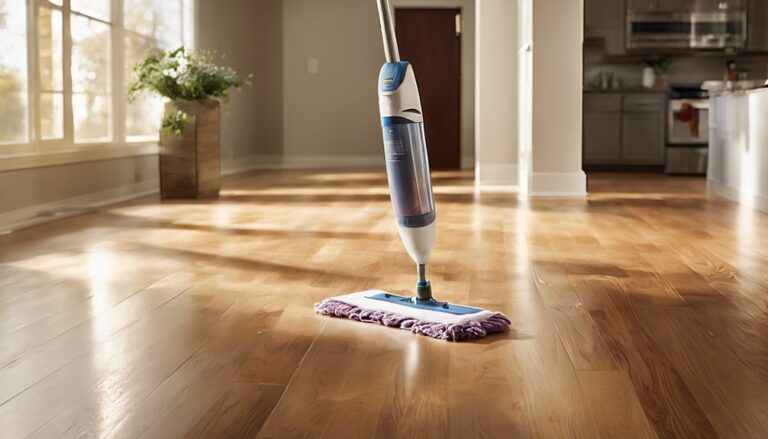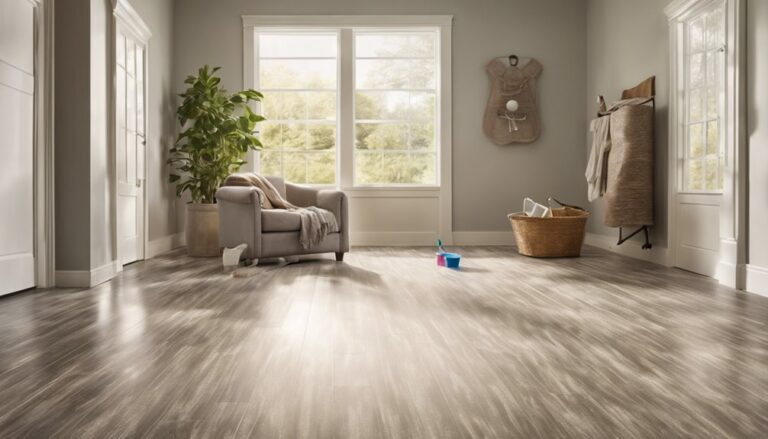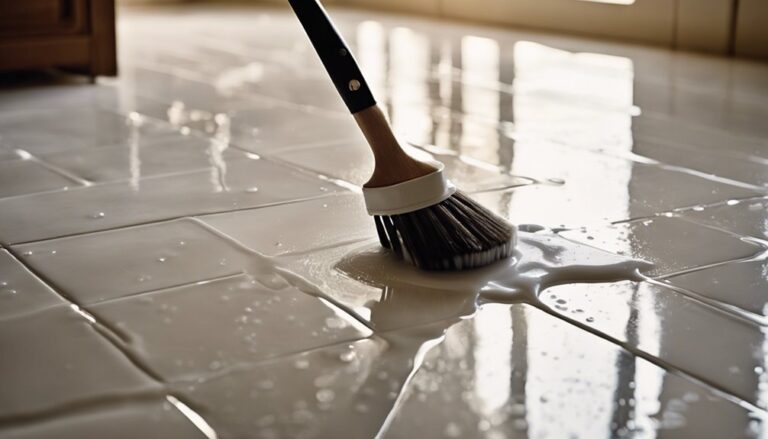Yes, vinyl plank flooring does need to acclimate before installation, typically for 48 to 72 hours. This acclimation stabilizes moisture and temperature within the planks to prevent expansion, contraction, warping, or gaps after installation. You’ll want to maintain a room temperature between 65-85°F and humidity of 40-60% during this period. Proper acclimation guarantees better dimensional stability and long-term performance. Continue to explore how acclimation and environmental factors affect your 床材‘s durability and appearance.
Understanding Vinyl Plank Flooring Composition
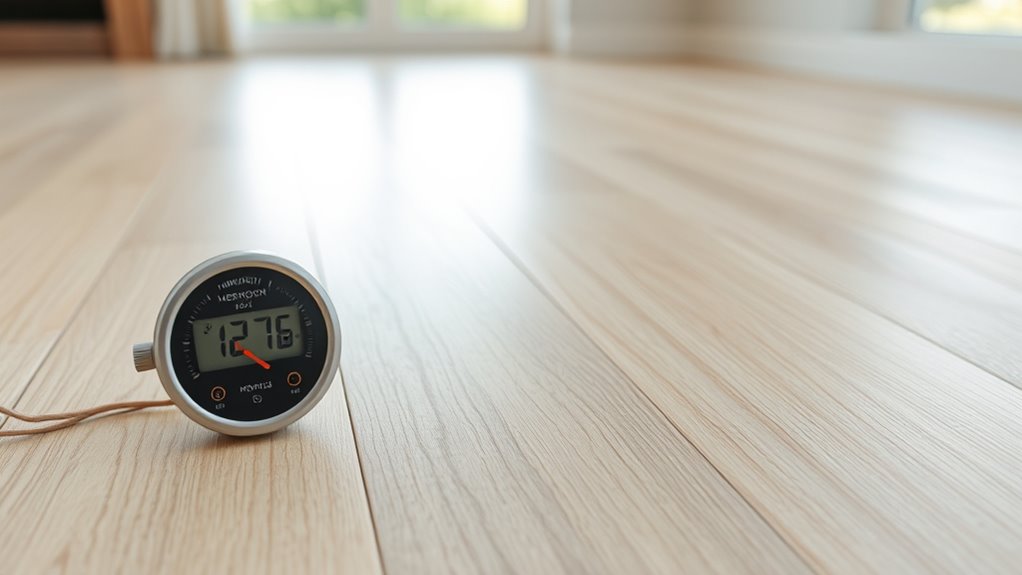
Vinyl plank flooring is engineered from multiple layers, each serving a specific function to guarantee durability, appearance, and performance. At its core, the vinyl composition includes a wear layer, printed design layer, and a backing layer. The wear layer protects against scratches and stains, ensuring longevity while maintaining the plank’s visual appeal. The printed design replicates natural materials like wood or stone, giving you aesthetic freedom without compromising resilience. The backing layer provides stability and moisture resistance, critical for maintaining structural integrity over time. Understanding these flooring materials helps you appreciate how vinyl plank flooring balances flexibility and toughness. This precise layering process allows you to install confidently in various environments, knowing the product is engineered to meet your lifestyle’s demands.
The Purpose of Acclimating Flooring Materials
You need to acclimate vinyl plank flooring to achieve proper moisture balance, which prevents expansion or contraction after installation. Adjusting the flooring to the room’s temperature guarantees dimensional stability and peak performance. Without this step, you risk gaps, buckling, or warping caused by environmental changes.
Moisture Balance Importance
Although it might seem like a simple step, acclimating flooring materials is essential to achieving proper moisture balance before installation. Without moisture control, vinyl plank flooring can expand, contract, or warp due to fluctuating humidity levels. You need to guarantee that the flooring’s moisture content matches the environment’s humidity regulation to maintain structural integrity.
Key reasons for moisture balance include:
- Preventing warping and buckling caused by moisture discrepancies
- Minimizing gaps or swelling between planks
- Guaranteeing adhesive effectiveness on subfloors
- Prolonging the flooring’s lifespan through stable moisture levels
温度調節のメリット
Since temperature fluctuations directly affect the dimensional stability of flooring materials, acclimating vinyl planks to the installation environment is crucial. By allowing your vinyl planks to undergo temperature adjustment, you guarantee they reach equilibrium with the room’s ambient conditions. This process minimizes expansion or contraction after installation, preserving flooring stability. If you skip acclimation, temperature differences can cause gaps, buckling, or warping as the planks adjust post-installation. Proper temperature adjustment also helps maintain the integrity of the locking mechanisms between planks, preventing long-term structural issues. Ultimately, acclimating your vinyl flooring reduces the risk of costly repairs and extends its lifespan. By controlling temperature variables before installation, you gain freedom from future dimensional problems and enjoy a durable, visually consistent floor.
How Vinyl Plank Flooring Reacts to Temperature Changes
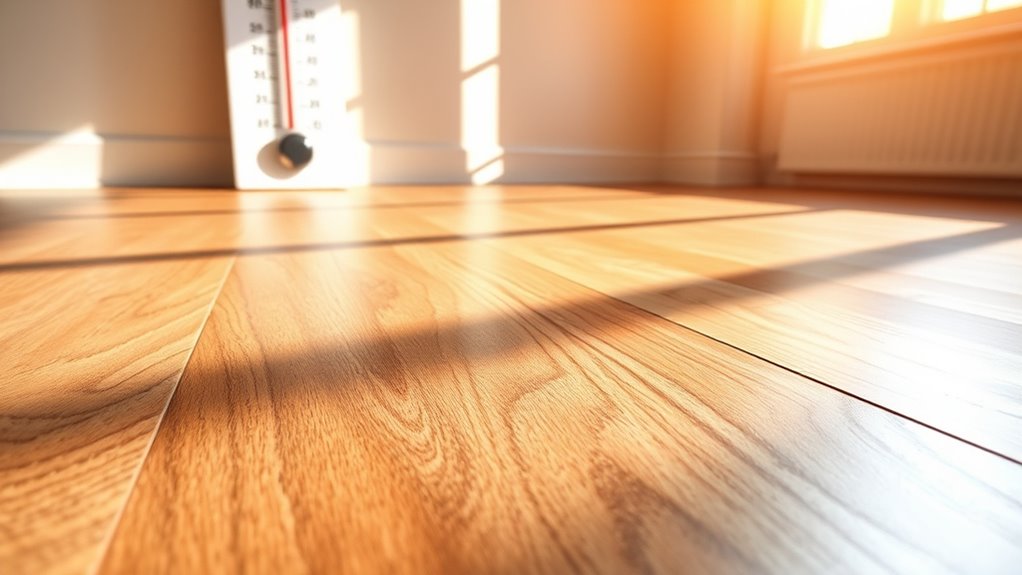
You’ll notice that vinyl plank flooring expands and contracts with temperature fluctuations, affecting its stability. Understanding how heat causes planks to expand and cold causes them to contract is essential for proper installation. This temperature sensitivity requires careful acclimation to prevent gaps or buckling after installation.
伸縮
Vinyl plank flooring expands and contracts as temperatures fluctuate, typically moving within a range of 1/8 to 1/4 inch per 10 feet. Understanding expansion factors and contraction causes is key to proper installation and performance. You’ll notice dimensional changes primarily due to:
- Temperature variation causing molecular movement
- Humidity levels affecting vinyl moisture content
- Subfloor material and its thermal response
- Installation method limiting or allowing plank movement
These factors mean you need to leave appropriate expansion gaps during installation to accommodate movement. Ignoring this can lead to buckling or gaps as planks react dynamically to environmental changes. By accounting for expansion and contraction precisely, you guarantee your vinyl plank flooring remains stable and durable, giving you the freedom to enjoy a flawless finish without worry.
Temperature Impact on Planks
Although temperature changes might seem minor, they markedly affect how vinyl plank flooring behaves. You’ll notice that temperature fluctuations cause the planks to undergo thermal expansion and contraction, which can lead to gaps or buckling if not properly managed. Acclimating your vinyl planks helps stabilize their dimensions before installation, reducing these risks.
| Temperature Range (°F) | Expansion Rate (mm/m) | Recommended Acclimation Time |
|---|---|---|
| 50 – 70 | 0.1 | 24時間 |
| 71 – 90 | 0.2 | 48 hours |
| Above 90 | 0.3 | 72 hours |
Humidity’s Impact on Vinyl Plank Flooring
Because moisture levels directly affect the dimensional stability of vinyl plank flooring, understanding humidity’s impact is essential before installation. Vinyl planks respond to varying humidity levels, which can cause expansion or contraction, potentially leading to gaps or buckling if not managed properly. You need to control humidity levels in the installation area to maintain flooring integrity. Key humidity effects to evaluate include:
- High humidity can cause vinyl planks to expand, stressing seams.
- Low humidity may lead to contraction, resulting in gaps.
- Fluctuating humidity levels increase stress cycles on the flooring material.
- Consistent indoor humidity (between 30%-50%) minimizes dimensional changes.
Manufacturer Recommendations for Vinyl Flooring Acclimation
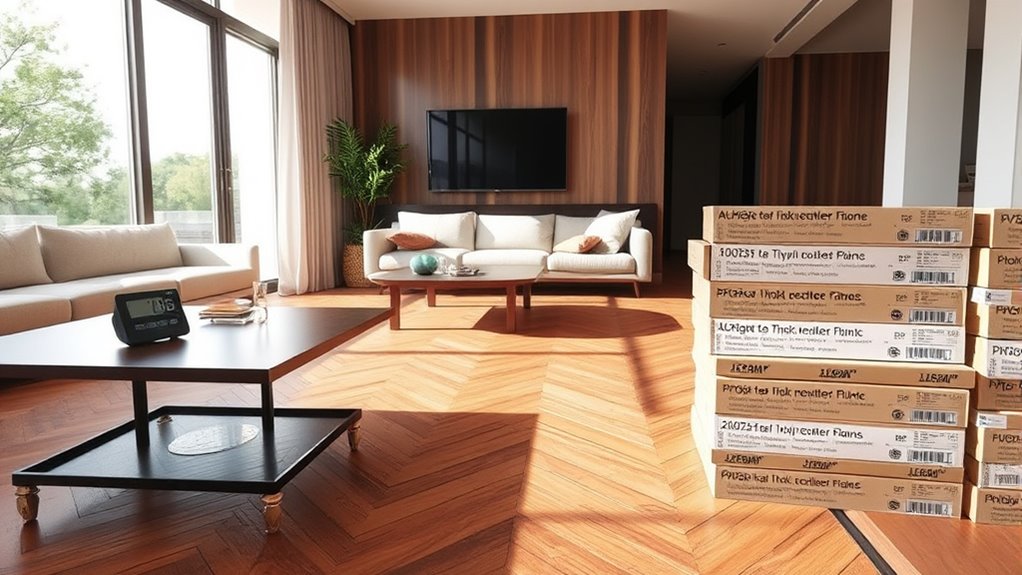
Managing moisture and humidity is only part of preparing your flooring for installation. Manufacturer guidelines emphasize specific acclimation factors such as temperature, duration, and environment to guarantee peak performance of vinyl plank flooring. Different brands may have varied recommendations, so it’s essential to consult the product-specific instructions.
| メーカー | Recommended Acclimation Time | Peak Temperature Range |
|---|---|---|
| ブランドA | 24-48 hours | 65°F – 85°F (18°C – 29°C) |
| ブランドB | 48 hours | 60°F – 80°F (16°C – 27°C) |
| ブランドC | No acclimation needed | Room temperature |
| Brand D | 72 hours | 70°F – 90°F (21°C – 32°C) |
Following these precise guidelines helps avoid warping, buckling, or gaps, giving you freedom from future flooring issues.
Steps to Properly Acclimate Vinyl Plank Flooring
To properly acclimate your vinyl plank flooring, you’ll need to set up an environment with stable temperature and humidity levels, ideally between 60-80°F and 40-60% humidity. Place the unopened flooring boxes flat in the installation area and avoid stacking them to guarantee even exposure. The recommended acclimation period typically ranges from 48 to 72 hours, depending on manufacturer guidelines and site conditions.
Ideal Acclimation Environment
Several key factors define the ideal acclimation environment for vinyl plank flooring, ensuring dimensional stability and proper installation. When preparing for the acclimation process, control environmental conditions to match those expected during flooring installation. This minimizes expansion or contraction risks.
Focus on these critical elements:
- Maintain indoor temperature between 60°F and 80°F (15°C–27°C)
- Keep relative humidity levels between 30% and 50%
- Store flooring flat and unopened on a clean, dry surface
- Avoid direct sunlight or heat sources that cause uneven warming
Recommended Acclimation Duration
Guaranteeing your vinyl plank flooring is properly acclimated involves adhering to specific timing guidelines that complement the ideal environment conditions. The recommended acclimation duration typically ranges from 48 to 72 hours, allowing the vinyl flooring to adjust to ambient temperature and humidity. This step minimizes expansion or contraction issues post-installation, preserving your floor’s integrity.
| Acclimation Duration | Environmental Condition |
|---|---|
| 48 hours | Temperature: 65-85°F |
| 72 hours | Humidity: 30-50% |
| >72 hours | Extreme climate variations |
You should store the vinyl flooring flat in the installation area during this period. Proper acclimation duration guarantees dimensional stability, granting you the freedom to install your vinyl flooring confidently and maintain its performance over time.
Risks of Skipping the Acclimation Process
Although skipping the acclimation process might seem like a time-saver, it can lead to significant issues with your vinyl plank flooring’s performance and longevity. The acclimation benefits include stabilizing the material to your room’s environment, which prevents costly installation consequences. Without proper acclimation, you risk:
- Warping or buckling due to moisture imbalances
- Gaps forming between planks as they contract or expand
- Adhesive failures from unexpected dimensional changes
- Premature wear caused by uneven stress on the flooring
Ideal Room Conditions Before Installation
Before you install vinyl plank flooring, your room’s temperature and humidity need to be within specific ranges to guarantee proper acclimation. Maintaining the ideal temperature and perfect humidity prevents expansion or contraction issues post-installation, ensuring lasting performance and freedom from warping.
| Parameter | Recommended Range |
|---|---|
| Ideal Temperature | 65°F to 85°F (18°C-29°C) |
| Perfect Humidity | 40% to 60% Relative Humidity |
| Acclimation Period | 48 to 72 hours |
| Room Ventilation | Moderate, consistent airflow |
| Subfloor Condition | Dry and clean |
Comparing Vinyl Plank to Other Flooring Types
When selecting flooring for your space, understanding how vinyl plank compares to alternatives like hardwood, laminate, or tile is essential for making an informed choice. Vinyl advantages include superior moisture resistance and flexibility in varied environments, unlike hardwood, which requires strict acclimation. Flooring comparisons reveal:
Vinyl plank flooring offers superior moisture resistance and flexibility compared to hardwood, laminate, or tile options.
- 耐久性: Vinyl resists scratches and dents better than hardwood and laminate.
- インストール: Vinyl planks often feature click-lock systems, simplifying DIY projects compared to tile’s complex setting process.
- メンテナンス: Vinyl demands less upkeep, resisting stains and moisture without special treatments.
- Cost-effectiveness: Vinyl generally offers a lower price point with similar aesthetic appeal to natural wood or stone.
Evaluating these factors helps you select flooring that aligns with your lifestyle and environmental conditions, ensuring long-term satisfaction.
Tips for Maintaining Vinyl Plank Flooring Post-Installation
Proper maintenance is essential for preserving the appearance and functionality of your vinyl plank flooring over time. Focus on effective cleaning techniques and damage prevention to guarantee longevity. Use a soft broom or vacuum without a beater bar to remove debris, and damp mop with a manufacturer-approved cleaner. Avoid harsh chemicals and excessive water. Prevent damage by placing protective pads under furniture and promptly wiping spills to avoid stains and warping.
| タスク | Recommended Method | 頻度 |
|---|---|---|
| Dust and debris | Soft broom or vacuum | Daily or as needed |
| Wet cleaning | Damp mop with gentle cleaner | 週刊 |
| Furniture protection | Felt pads under legs | Continuous |
| Spill management | Immediate wipe with cloth | 必要に応じて |
Following these practices maximizes your flooring’s durability and maintains its pristine look.

